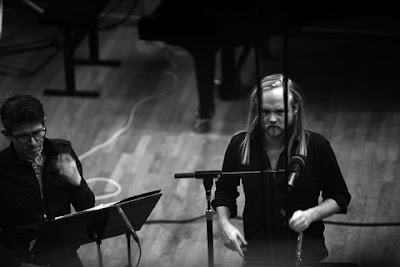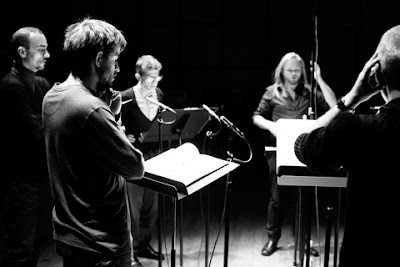Guillaume de Machaut Messe de Nostre Dame and mass propers; Graindelavoix, Bjorn Schmelzer; Glossa
Reviewed by Robert Hugill on May 17 2016
Star rating:
A refreshing and invigorating view of Machaut's masterpiece, in the tradition of Marcel Peres and Ensemble Organum
In his talk Reconstructing Historical Singing – Reality or Fantasy? (given as part of Kings Place's study day How to be HIP – Historically Informed Performance; Here and Now, Why and How) Richard Wistreich asked two questions, if we reconstructed baroque vocal technique would we like it, and is it worth? This same questions could be asked of medieval performance techniques? If we knew how medieval polyphony was sung, would we like the results? Most modern performers generally simply sidestep the issues.
This new disc of Guillaume de Machaut's Messe de Nostre Dame from Bjorn Schmelzer and Graindelavoix on Glossa makes us ask just such questions. Put the first track on and we are presented with a vibrant, highly energised sound world rather a long way from the poised perfection of, say, the Hilliard Ensemble. What is going on?
Reviewed by Robert Hugill on May 17 2016
Star rating:
A refreshing and invigorating view of Machaut's masterpiece, in the tradition of Marcel Peres and Ensemble Organum
In his talk Reconstructing Historical Singing – Reality or Fantasy? (given as part of Kings Place's study day How to be HIP – Historically Informed Performance; Here and Now, Why and How) Richard Wistreich asked two questions, if we reconstructed baroque vocal technique would we like it, and is it worth? This same questions could be asked of medieval performance techniques? If we knew how medieval polyphony was sung, would we like the results? Most modern performers generally simply sidestep the issues.
This new disc of Guillaume de Machaut's Messe de Nostre Dame from Bjorn Schmelzer and Graindelavoix on Glossa makes us ask just such questions. Put the first track on and we are presented with a vibrant, highly energised sound world rather a long way from the poised perfection of, say, the Hilliard Ensemble. What is going on?
 |
| Bjorn Schmelzer & Graindelavoix - photo © Koen Bros, Marius Peterson |
This is in fact rather more helpful than Schmelzer's essay in the CD booklet. His text is highly learned but rather dense in its language. Phrases like 'Finally, we can return the "Messe de Nostre Dame" into its pre-modern(ist) or post-modern state, making its hybridigy emerge again through diagrammatic, operative performance'. A passing reference to Marcel Peres gives us a clue. Peres recorded Guillaume de Machaut's Messe de Nostre Dame with his Ensemble Organum in the 1990s. Famously Peres incorporated elements of Middle Eastern, Byzantine and Jewish chant performance, and used singers from Corsican polyphonic folk traditions.
 |
| Bjorn Schmelzer & Graindelavoix - photo © Koen Bros, Marius Peterson |
Schmelzer and his group also take Guillaume de Machaut's manuscript as a starting point rather than using it as an absolute. They take the silences on certain subjects as an indicator of some sort of oral tradition. What the performances intend to do is to revitalise the modern tradition of performing Machaut and to look at the music in a new light. We don't know that performances sounded like this, and we don't know that they didn't.
A lot of careful research has gone into the disc, the accompanying plainchant propers for a Laydmass come from BM224, a missal from Rheims, and they are elaborated and embellished based on other plainchant sources.
Not everyone will like the performance, with the folk-singer-ish vocal quality, the bending of the notes, the rhythmic freedom, the sense of fluid improvisation and the the feeling of the 10 being co-creators of the music. But I found it invigorating, and a refreshing contrast to the purity and perfection of much of the Western Classical tradition. Guillaume de Machaut's Messe de Nostre Dame may not indeed have sounded like this, but the performance really makes us think.
GUILLAUME DE MACHAUT (c1300-1370) - Messe de Nostre Dame
01 Inviolata genitriz / Felix virgo / Ad te suspiramus gementes et flentes - Motet by Guillaume de Machaut
02 Introitus: Salve sancta parens - Anonymous (plainchant)
03 KYRIE, Messe de Nostre Dame - Guillaume de Machaut
04 GLORIA, Messe de Nostre Dame - Guillaume de Machaut
05 Graduale: Benedicta et venerabilis es virgo Maria - Anonymous (plainchant)
06 Alleluya: Post partum virgo - Anonymous (plainchant)
07 Prosa: Verbum bonum et suave - Anonymous (plainchant & version Codex Las Huelgas)
08 CREDO, Messe de Nostre Dame - Guillaume de Machaut
09 Plange, regni respublica / Tu qui gregem tuum ducis / Apprehende arma et scutum et exurge - Motet by Guillaume de Machaut
10 SANCTUS, Messe de Nostre Dame - Guillaume de Machaut
11 AGNUS DEI, Messe de Nostre Dame - Guillaume de Machaut
12 Communio: Beata viscera - Anonymous (plainchant) & Perotinus (conductus)
13 ITE MISSA EST, Messe de Nostre Dame - Guillaume de Machaut
Graindelavoix (Francois Testory, Paul de Troyer, Marius Peterson, Adrian Sirbu, David Hernandez, Tomas Maxe, Bart Meynckens, Arnout Malfliet, Jean-Christophe Brizard)
Recorded in St Augustine's Church, Antwerp 25-31 March 2015
GLOSSA GCD P32110 1CD [72.50]
Available from Amazon.co.uk.
Elsewhere on this blog:
- Elegance of sound:: Singapore Symphony Orchestra & Gil Shaham at the Dresden Music Festival - concert review
- Cultural contrast: Ukulele Orchestra of GB in Dresden's Semperoper at the Dresden Music Festival - concert review
- Musical City: amateurs and professionals combine for Dresden's day of music - concert review
- Young talent: I talk to American pianist/composer Thomas Nickell - interview
- Seductive & luminous: Clare Hammond plays Kenneth Hesketh - CD review
- Tribute: In memoriam from the choir of King's College, London, dedicated to the memory of David Trendell - CD review
- A remarkable achievement: Jonathan Harvey sung by the choir of St John's College, Cambridge - CD review
- Last but not least: Rachel Podger and the European Union Baroque Orchestra - concert review
- Irresistible warmth & charm: Profeti della Quinta in Salomone Rossi - concert review
- The 1810s in Song: First volume of Vivat's Decades project - CD review
- God spake the word: Handel's Israel in Egypt - Concert review
- Energetic Shakespeare celebrations: Ex Cathedra in Arne and Sally Beamish - concert review
- Home




,%20William%20Morgan%20(Male%20Chorus)%20(c)%20Richard%20Hubert%20Smith.jpg)


,%20Giorgio%20Vasari,%20Palazzo%20Vecchio,%20Florence.jpg)

.jpg)
%20Benjamin%20Ealovega.jpg)

No comments:
Post a Comment